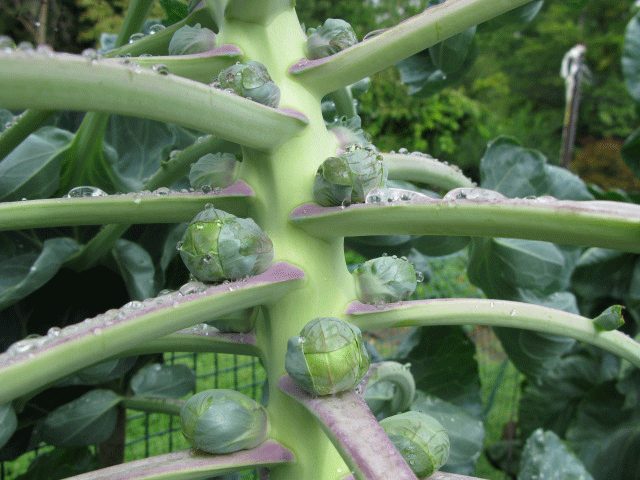These traditional winter vegetables can be picked fresh from late summer to mid-spring; the plants are strong and can survive severe winters. Most modern cultivars are F1 hybrids, producing uniform plants and compact sprouts. Plants grown to full height can produce 60–70 sprouts each; weight depends on the size they are allowed to reach. The small buttons are excellent for freezing. There is also a small crop of leafy tops. Sprouts are suitable for intercropping, for example, with fast-growing salads.
Site and soil
Brussels sprouts do well in firm, fertile soils, with plenty of organic matter incorporated well in advance. Lime if necessary to raise the soil pH to deter clubroot. Before sowing or planting, apply a base dressing of fertilizer, except on highly fertile soil—too much nitrogen produces loose, leafy sprouts.
Sowing and planting
Sow under cover in late winter for an early crop in late summer and early fall. For winter crops, sow from early to mid-spring, outdoors in a seedbed or under cover in trays, and transplant to the cropping site in early to midsummer. Close planting (less than 2 ft/60 cm each way), for example, on narrow beds, will produce smaller sprouts of uniform maturity, while wider spacing will yield larger sprouts to be picked in succession over a longer period. Sowing different cultivars to mature at varying times will ensure a long cropping period. Keep seedlings and new transplants well watered. Brassica collars will protect young plants against cabbage root fly.
SOWING DEPTH ¾ in (2 cm)
PLANT SPACING 2 ft (60 cm)
ROW SPACING 2 ft (60 cm)
Routine care
To produce small, evenly sized sprouts that will mature simultaneously, for example, for freezing, pinch out the growing tips of the plants when the lower sprouts are ½in (1 cm) in diameter. To encourage the sprouts to fill out, top-dress in midsummer with sulfate of ammonia at a rate of 1–2 oz per sq yd (25–50 g per sq m). Water after topdressing. Once established, plants should grow away without further watering unless there is a period of severe drought. Overwintering plants need supporting with stakes, especially on light, sandy soils.
Harvesting
Starting from the bottom of the plant, pick when the sprouts reach ¾–1¼in (2–3 cm) in diameter for the sweetest taste; snap them off with a downward motion. At the same time, remove any yellow leaves and discard any loose or yellow sprouts. Whole stems or sticks of sprouts keep well standing in a little water in a bucket in a cool place. Later in the season, the leafy tops of the plants can also be picked as greens.
Common problems
For advice on protecting young plants against cabbage root fly and birds. Caterpillars, especially those of the cabbage white butterfly, can cause extensive crop damage. Flea beetle may be troublesome in dry weather and sheltered spots. Large colonies of mealy cabbage aphids can quickly establish, causing distorted foliage. Do not mistake them for whitefly ; although this can be a conspicuous pest, it rarely causes significant damage, although in mild winters whitefly can persist on brassicas to affect other young plants in spring. Other pests include cutworm, leather jackets, and slugs and snails.
In addition to clubroot, brassicas are susceptible to leaf diseases such as downy mildew, and powdery mildew. Bacterial leaf spot and white blister are becoming more widespread problems.
Plants grown well and fed correctly rarely suffer nutrient deficiencies. Hollow stems may indicate boron deficiency. Poor seedling growth can be the result of molybdenum deficiency.
Recommended cultivars
Cronus hybrid, mid season variety, resistant to clubroot.
Diablo hybrid, good flavor, crops early.
Evesham Special old, traditional cultivar.
Falstaff rosy sprouts are simply delicious, with a mild, nutlike flavor.
Nautic plants are vigorous and sturdy, averaging 30 in (75 cm) tall.
Red Bull small red sprouts, color improves in cold weather
Rubine a striking addition to any vegetable patch and a gourmet special for your table.


